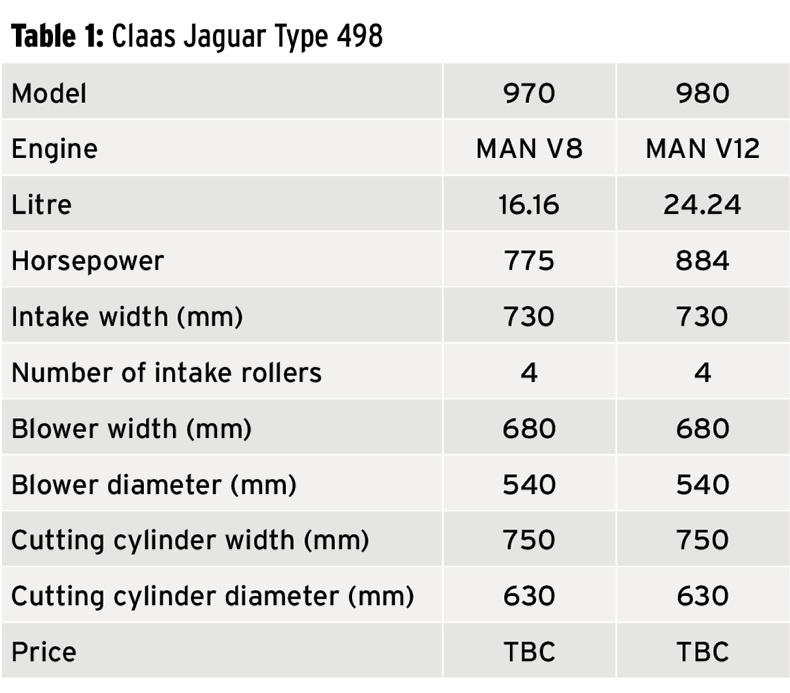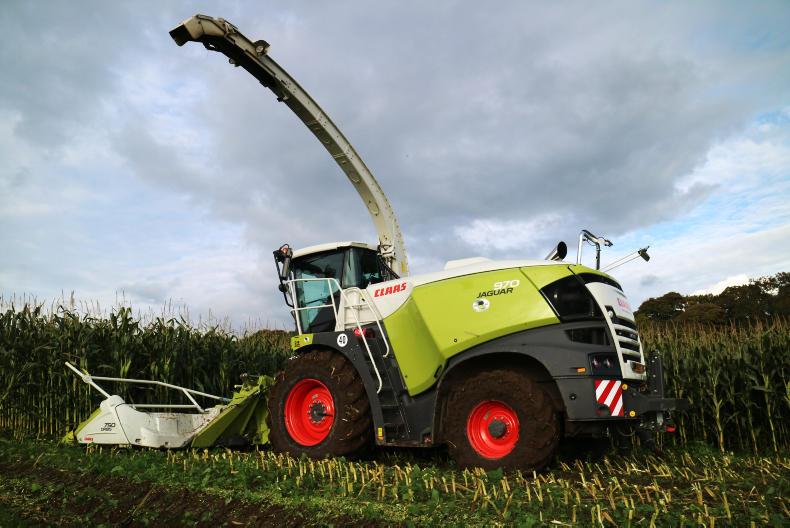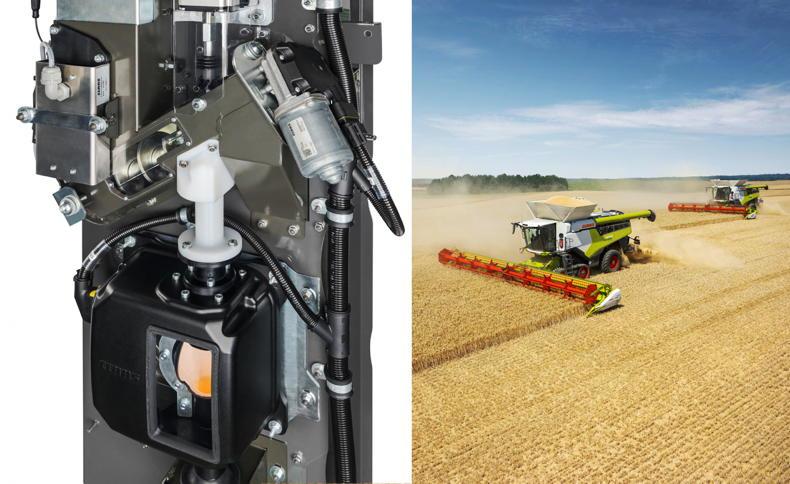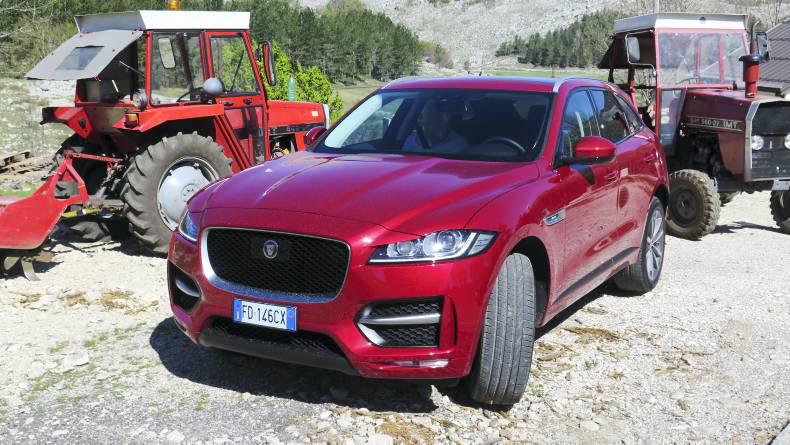Claas has just announced an updated version of its flagship 970 and 980 models with some clever tweaks to help improve operator comfort, performance and efficiency. I caught up with UK-based contractor Andrew Long who has run a pre-series 970 at silage, whole crop and maize to see what is new on the Jaguar.
Engines
Under the bonnet, the engines remain the same as the previous models, with the 970 coming with a 16.16-litre V8 Man engine producing 775hp, while the larger 980 comes with a massive 24.24-litre V12 Man engine which pumps out 884hp. The only real update engine-wise is a newly designed rear panel to help improve airflow around the engine to improve cooling. The side panels are now also one piece, with no ledges for material to lodge, helping to keep the machine cleaner.
Transmission
Although the engines remain the same, the transmission has been changed completely. The old single hydrostatic motor has now been replaced by a new dual motor unit which, according to Claas, offers more torque to the wheels, making it more responsive. Limited slip differentials can be specified for both axles as an option which can be controlled either manually; in automatic switch-on mode, which is triggered when wheel slip is detected; or in automatic switch-off mode, when a given steering angle and speeds greater than 15km/h are attained.
The axles have been beefed up to a 10-stud version, while both models now also get an automatic parking brake which is applied when the operator places the control lever in the neutral position, which aids safety.
On the road, the Jaguar can easily travel along at 40km/h as before, but now at a reduced engine speed of 1,300rpm, which helps to save fuel. Claas has also taken its fuel-saving approach to work in the field. When the pickup is raised out of work mode, the computer detects that the feed rollers are closed with no material between them and will automatically drop the engine revs from 2,000rpm to 1,400rpm without affecting the forward speed. Once the headland turn is completed, for example, and the pickup is lowered again, the engine revs automatically return to 2,000rpm ready for the next swath.
Sam Long, who has been driving the forager all year, commented: “The fuel consumption is definitely improved on this model as opposed to our older 970, although I can’t put an exact figure on it.”
Sharpener
Moving towards the blades, the sharpening unit has been improved to reduce flex and vibration as well as stopping the sharpening stone being pushed outwards as it passes over the centre of the cutting drum. This is achieved by strengthening the track which the sharpening stone runs along. Claas claims the new design improves sharpening accuracy and knife life.
Shear bar
The shear bar design has been tweaked in numerous ways to improve efficiency and blade wear. The shear bar mechanism is now hydraulically clamped in place as opposed to being bolted on the previous models. Claas claims the new system allows for a much easier adjustment of the shear bar, which is now also repositioned so as that it is a true 900 to the blades. This is said to result in a better chop quality and extended blade life. In addition, the shear bar itself is bolted down with four high-tensile bolts instead of three previously.
The link arms which adjust the shearbar have also been beefed up. This is because they are now directly linked to the concave or belly band under the chopping cylinder. The result of this is that when the shear bar is adjusted, so too is the concave. This keeps the gap between it and the cylinder at a constant distance, which is something often neglected with the old manual system.
Owner Andrew commented on all the new updates around the intake and how it has affected blade wear: “We were able to get 3,500 acres on average out of a set of blades on our previous 970. The new updates have allowed us to extend this to 5,000 acres on this machine.”
Split drive
Moving up to the front of the machine, Claas has designed a new split drive option to improve throughput. Previously, drive to the pickup was a fixed mechanical speed, with only the feed roller hydraulically driven and adjustable to alter chop length. The split drive option features a second hydraulic drive system which independently alters the pickup speed and can be controlled from the cab. To prevent parasitic losses from the hydraulic drive lines, final drive is extended using drive shafts, which Claas claims is more efficient.
When working the split drive in auto mode, the pickup speed alters automatically in relation to the feed roller speed. For example, if a short chop length is required, you may want the header to slow down so it does not over feed the feed rollers. Alternatively, you can run it in manual mode which allows you to adapt to changing crop conditions such as when working in grass, switching between light and heavy swaths.
Only the pickup and maize header can be used with the hydraulic drive system. For direct disc or whole crop headers where full power and a constant speed are required, the new hydraulic drive system can be combined with the forager’s mechanical drive system. To revert back to hydraulic drive, the drive belt is simply removed from the mechanical drive system which Claas says takes no longer than a couple of minutes.
Attachment recognition
With the new split drive system, attachment recognition is now a feature which tells the forager what is on front of it, what width it is and what speed it is able to run at. The grass pickup will now be equipped with an Active Contour function that enables fast adaptation to changing ground contours, reducing crop losses in hilly terrain. The new function works in conjunction with pressure sensors in the auger’s lift cylinders, and combines them with another sensor that monitors movement between the pickup and the auger.
Claas now offers a rear version of its side auto fill option which can automatically control the spout when filling into a trailer which is following the forager, for example when opening a field or set in maize or whole crop. The auto fill system uses a special camera that can target the centre line of the trailer and follow it around slight corners and bends. This takes the strain away from the operator, leaving them free to concentrate on what is happening up front and only having to control the flap angle.
The auto side and rear filling use the same camera, meaning the operator has to manually switch between modes as the rear system requires the camera to zoom in order to work. A slight fault I feel is that the rear mode only works when the trailer is being pulled by a tractor in between the forager and trailer, which in some cases is not ideal. The zoom camera cannot identify the rear of the trailer when the trailer is fitted on the forager’s pickup hitch.
For now, the updates are only coming on the top-of-the-range 970 and 980 models, but Claas has confirmed that much of the new technology will trickle down the rest of the range in the near future. The new 970 and 980 models are now available to order, with production to start in December. Prices, however, are yet to be confirmed but one can only assume the new updates come at an increased cost.
















SHARING OPTIONS